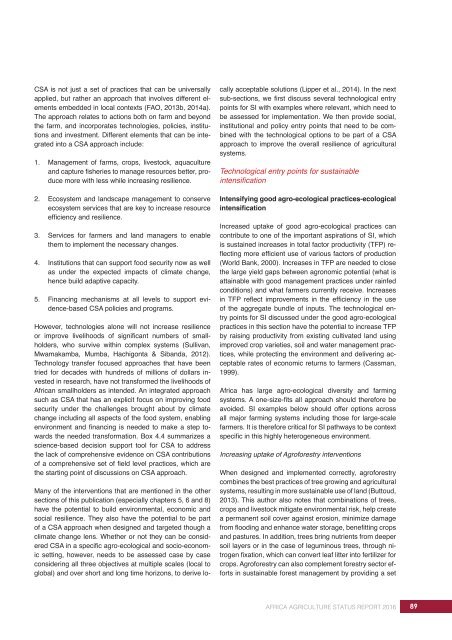AFRICA AGRICULTURE STATUS REPORT 2016
AASR-report_2016-1
AASR-report_2016-1
Create successful ePaper yourself
Turn your PDF publications into a flip-book with our unique Google optimized e-Paper software.
CSA is not just a set of practices that can be universally<br />
applied, but rather an approach that involves different elements<br />
embedded in local contexts (FAO, 2013b, 2014a).<br />
The approach relates to actions both on farm and beyond<br />
the farm, and incorporates technologies, policies, institutions<br />
and investment. Different elements that can be integrated<br />
into a CSA approach include:<br />
1. Management of farms, crops, livestock, aquaculture<br />
and capture fisheries to manage resources better, produce<br />
more with less while increasing resilience.<br />
2. Ecosystem and landscape management to conserve<br />
ecosystem services that are key to increase resource<br />
efficiency and resilience.<br />
3. Services for farmers and land managers to enable<br />
them to implement the necessary changes.<br />
4. Institutions that can support food security now as well<br />
as under the expected impacts of climate change,<br />
hence build adaptive capacity.<br />
5. Financing mechanisms at all levels to support evidence-based<br />
CSA policies and programs.<br />
However, technologies alone will not increase resilience<br />
or improve livelihoods of significant numbers of smallholders,<br />
who survive within complex systems (Sullivan,<br />
Mwamakamba, Mumba, Hachigonta & Sibanda, 2012).<br />
Technology transfer focused approaches that have been<br />
tried for decades with hundreds of millions of dollars invested<br />
in research, have not transformed the livelihoods of<br />
African smallholders as intended. An integrated approach<br />
such as CSA that has an explicit focus on improving food<br />
security under the challenges brought about by climate<br />
change including all aspects of the food system, enabling<br />
environment and financing is needed to make a step towards<br />
the needed transformation. Box 4.4 summarizes a<br />
science-based decision support tool for CSA to address<br />
the lack of comprehensive evidence on CSA contributions<br />
of a comprehensive set of field level practices, which are<br />
the starting point of discussions on CSA approach.<br />
Many of the interventions that are mentioned in the other<br />
sections of this publication (especially chapters 5, 6 and 8)<br />
have the potential to build environmental, economic and<br />
social resilience. They also have the potential to be part<br />
of a CSA approach when designed and targeted though a<br />
climate change lens. Whether or not they can be considered<br />
CSA in a specific agro-ecological and socio-economic<br />
setting, however, needs to be assessed case by case<br />
considering all three objectives at multiple scales (local to<br />
global) and over short and long time horizons, to derive locally<br />
acceptable solutions (Lipper et al., 2014). In the next<br />
sub-sections, we first discuss several technological entry<br />
points for SI with examples where relevant, which need to<br />
be assessed for implementation. We then provide social,<br />
institutional and policy entry points that need to be combined<br />
with the technological options to be part of a CSA<br />
approach to improve the overall resilience of agricultural<br />
systems.<br />
Technological entry points for sustainable<br />
intensification<br />
Intensifying good agro-ecological practices-ecological<br />
intensification<br />
Increased uptake of good agro-ecological practices can<br />
contribute to one of the important aspirations of SI, which<br />
is sustained increases in total factor productivity (TFP) reflecting<br />
more efficient use of various factors of production<br />
(World Bank, 2000). Increases in TFP are needed to close<br />
the large yield gaps between agronomic potential (what is<br />
attainable with good management practices under rainfed<br />
conditions) and what farmers currently receive. Increases<br />
in TFP reflect improvements in the efficiency in the use<br />
of the aggregate bundle of inputs. The technological entry<br />
points for SI discussed under the good agro-ecological<br />
practices in this section have the potential to increase TFP<br />
by raising productivity from existing cultivated land using<br />
improved crop varieties, soil and water management practices,<br />
while protecting the environment and delivering acceptable<br />
rates of economic returns to farmers (Cassman,<br />
1999).<br />
Africa has large agro-ecological diversity and farming<br />
systems. A one-size-fits all approach should therefore be<br />
avoided. SI examples below should offer options across<br />
all major farming systems including those for large-scale<br />
farmers. It is therefore critical for SI pathways to be context<br />
specific in this highly heterogeneous environment.<br />
Increasing uptake of Agroforestry interventions<br />
When designed and implemented correctly, agroforestry<br />
combines the best practices of tree growing and agricultural<br />
systems, resulting in more sustainable use of land (Buttoud,<br />
2013). This author also notes that combinations of trees,<br />
crops and livestock mitigate environmental risk, help create<br />
a permanent soil cover against erosion, minimize damage<br />
from flooding and enhance water storage, benefitting crops<br />
and pastures. In addition, trees bring nutrients from deeper<br />
soil layers or in the case of leguminous trees, through nitrogen<br />
fixation, which can convert leaf litter into fertilizer for<br />
crops. Agroforestry can also complement forestry sector efforts<br />
in sustainable forest management by providing a set<br />
<strong>AFRICA</strong> <strong>AGRICULTURE</strong> <strong>STATUS</strong> <strong>REPORT</strong> <strong>2016</strong><br />
89


